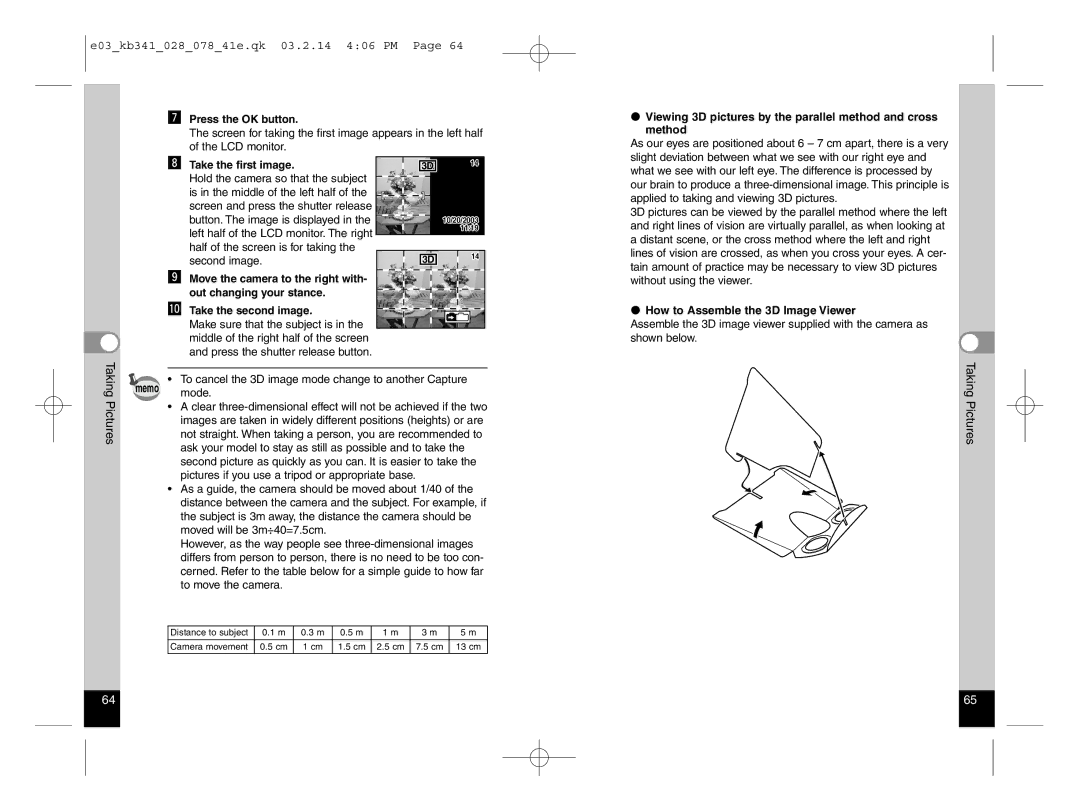
e03_kb341_028_078_41e.qk 03.2.14 4:06 PM Page 64
mPress the OK button.
The screen for taking the first image appears in the left half of the LCD monitor.
, Take the first image. | 14 |
Hold the camera so that the subject |
|
is in the middle of the left half of the |
|
screen and press the shutter release |
|
button. The image is displayed in the | 10/20/2003 |
left half of the LCD monitor. The right | 11:19 |
| |
half of the screen is for taking the |
|
second image. | 14 |
|
. Move the camera to the right with- out changing your stance.
⁄0Take the second image.
Make sure that the subject is in the middle of the right half of the screen and press the shutter release button.
Taking | memo |
|
|
|
|
|
|
|
mode. |
|
|
|
|
|
| ||
Pictures |
| • To cancel the 3D image mode change to another Capture | ||||||
| • A clear | |||||||
|
| |||||||
|
| images are taken in widely different positions (heights) or are | ||||||
|
| not straight. When taking a person, you are recommended to | ||||||
|
| ask your model to stay as still as possible and to take the | ||||||
|
| second picture as quickly as you can. It is easier to take the | ||||||
|
| pictures if you use a tripod or appropriate base. |
| |||||
|
| • As a guide, the camera should be moved about 1/40 of the | ||||||
|
| distance between the camera and the subject. For example, if | ||||||
|
| the subject is 3m away, the distance the camera should be | ||||||
|
| moved will be 3m÷40=7.5cm. |
|
|
|
| ||
|
| However, as the way people see | ||||||
|
| differs from person to person, there is no need to be too con- | ||||||
|
| cerned. Refer to the table below for a simple guide to how far | ||||||
|
| to move the camera. |
|
|
|
|
| |
|
|
|
|
|
|
|
|
|
|
| Distance to subject | 0.1 m | 0.3 m | 0.5 m | 1 m | 3 m | 5 m |
|
|
|
|
|
|
|
|
|
|
| Camera movement | 0.5 cm | 1 cm | 1.5 cm | 2.5 cm | 7.5 cm | 13 cm |
|
|
|
|
|
|
|
|
|
Viewing 3D pictures by the parallel method and cross method
As our eyes are positioned about 6 – 7 cm apart, there is a very slight deviation between what we see with our right eye and what we see with our left eye. The difference is processed by our brain to produce a
3D pictures can be viewed by the parallel method where the left and right lines of vision are virtually parallel, as when looking at a distant scene, or the cross method where the left and right lines of vision are crossed, as when you cross your eyes. A cer- tain amount of practice may be necessary to view 3D pictures without using the viewer.
How to Assemble the 3D Image Viewer
Assemble the 3D image viewer supplied with the camera as shown below.
Taking Pictures
64 |
| 65 |
|
|
|
